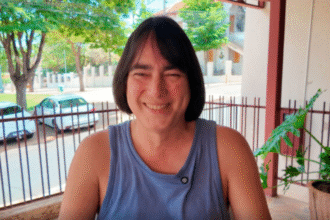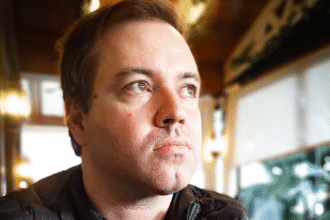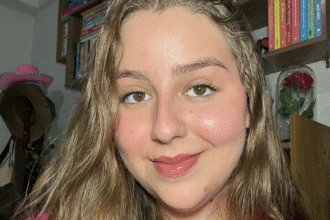Bel is a little girl full of curiosity, always wondering why things happen. With her faithful kitten Galileo as her sidekick, she embarks on exciting experiments and discoveries that reveal how science is present in every aspect of our lives, from our mobile phones to the food we eat. Scientist and professor of medicine Bruno Gualano guides the children through this universe in the book “Bel, the experimenter”, published by Moah! Editora.
Bel has no limits in her quest for knowledge. She builds homemade volcanoes and mixes colour- changing chemicals in test tubes. However, when her friends from Marie Curie Street begin to suspect that she is a little witch, Bel invites them on an incredible scientific journey. With experiments, she shows them what energy is, such as rubbing a bladder on her woollen blouse and then bringing it close to Galileo the kitten, who gets goose bumps. These experiments enchant the children in the street, turning science into a “game of experiment”.
The book honours notable figures in history, such as Galileo Galilei, Marie Curie and Mercedes Bustamante, and aims to promote scientific literacy in childhood, helping children to understand natural, social and technological phenomena from a scientific perspective. The Catarina Bessel’s creative illustrations, using collage as a technique, make the narrative even more engaging and entertaining. In addition, the book addresses important themes such as cultural diversity, anti-racist education and the representation of women in science, featuring a black protagonist. Natalia Pasternak, a science communicator, supports this publication, highlighting its role in breaking down stereotypes about scientists and democratising science.
Supported by USP’s Faculty of Medicine, “Bel, the experimenter” is the first in a series of books aimed at children up to the age of 9. The next volumes will cover topics such as vaccines, climate change and bullying related to body stigmas, promoting a rich and diverse early childhood education.
“Bel, the experimenter” aims to encourage scientific literacy in children. How does the book manage to make science accessible and engaging for young readers?
Bel introduces science to children in a playful way, unravelling its relationship with society and nature. This is the backdrop that allows children to discover that science is present in everything around us.
The book pays homage to notable figures in the history of science, such as Galileo Galilei and Marie Curie. How does the narrative make use of these inspiring figures?
It is part of scientific literacy to introduce children to historical scientific figures. Their achievements need to reach the little ones, because they inspire them. Each volume of the collection mentions well- known scientists, not forgetting Brazilians. The mini-biography of those honoured at the end of the book is an invitation for children to immerse themselves in the life and work of these scientists whose contributions have changed the way we see the world.
The book’s protagonist, Bel, is a curious young girl. How does your character demonstrate the importance of scientific exploration and curiosity to children?
Curiosity is an inherent characteristic of a scientist. It’s what makes us think about why things are the way they are and how we can change what isn’t going well. Bel’s experimentation is nothing more than an exercise in what you call scientific exploration. Trial and error is part of this process, as Bel shows us when she builds her volcano. It’s up to us adults to encourage experimentation and never to stifle curiosity, a trait that is so natural in childhood.
In addition to the scientific focus, what other important themes, such as cultural diversity and anti- racist education, are addressed in the book? 5. The protagonist Bel is a black child. How is the representation of women and minorities in science explored in the story?
Science is for everyone. This is the message the book sends out. However, women and blacks, for example, are under-represented in academia. This distorts the production of knowledge and creates a gap in scientific evidence in crucial areas such as public health, security and culture. Look: the world’s most prestigious journal, Nature, took 150 years to have its first editor-in-chief. USP’s Faculty of Medicine, where I work, took 110 years to give way to a woman as its head. Bel is black, a girl and an experimenter. Our society needs to see this as natural. And the most curious thing is that I’ve never heard any child question why Bel is the way she is; all the questions have come from adults. It seems to me, in a way, to be a hope or an evolution (laughs)…
You mentioned that “Bel, the experimenter” is part of a collection aimed at audiences up to 9 years old. What other themes and topics can the public expect in the next publications in this series?
Exactly. Bel is a scientific literacy collection. In the oven is Bel and the Marvellous Invisible Shield, which will tell children about the importance of one of humanity’s greatest inventions: vaccines. And there are also volumes coming out on global warming and bullying, from the point of view of science, in light and entertaining language for children.

As a professor of medicine and an influential scientist, how do you think popularising science from an early age can benefit the development of critical and well-informed individuals?
Scientific literacy is not an all-or-nothing question, i.e. whether or not a person is literate in science. The discovery of science is a continuum and involves stages that cannot be skipped. In childhood, recognising the presence of scientific phenomena in our daily lives is a fundamental goal. The child who is introduced to Ruth Rocha, Monteiro Lobato and Ziraldo is not expected to become a writer. In the same way, I don’t expect Bel or any other work of scientific literacy to train scientists. Rather, the aim is to train thinking, critical citizens. What’s more, it’s a child’s legitimate right to have access to the cultural goods produced by humanity, which include, for example, literature and science.
What was it like working with illustrator Catarina Bessel, and how does the use of collage contribute to the readers’ experience?
Catarina is a brilliant artist. Her sensitivity and creativity are unrivalled and have contributed greatly to the final quality of the work. There isn’t a child (or an adult) who won’t be enchanted by her illustrations. In the end, I think we made a good duo because, above all, we share the same ideals that are conveyed in the book. It’s a privilege to have her in this project.
In addition to this book, you are known for your science communication initiatives, such as the “Ciência inForma” channel and the “O Cientista Não Morde” podcast. How does children’s literature fit into your wider efforts to promote science?
I also have a column in Folha de S. Paulo. These are all spaces for communicating science to adults. I missed talking to children. I have a school-age daughter and I began to realise that the few books that talk about science for children are foreign. That’s how I came up with this project to bring science to children, with typically Brazilian characters and environments, capable of making the reader identify with them. I often joke that we scientists are very good at communicating what we do to the 7 other scientists who are researching the same thing as us. Of course, that’s not enough. We need to get out of the way and show that the science we do in the lab is in people’s everyday lives. That’s why it’s worth valuing science, whose investment is paid for by society. Communicating science today is an act of survival for scientists. What’s more, there’s nothing more gratifying when non-specialist citizens recognise that what we do has social value.
The book emphasises the idea that love is the common thread of life. Can you explain how this idea is interwoven with the scientific narrative of the story?
I would say that the leitmotif of the narrative is experimentation with life and the world. Throughout the story, I try to demystify the idea that science is something supreme, unattainable, something destined for a few beings enlightened by the gift of knowledge. By naturalising Bel’s curiosity and “experimental play”, I hope that children will have a lighter and more enjoyable first contact with science, which will allow them to see it as a good alternative to the beauties and mishaps of the world.
Follow Bruno Gualano on Instagram





